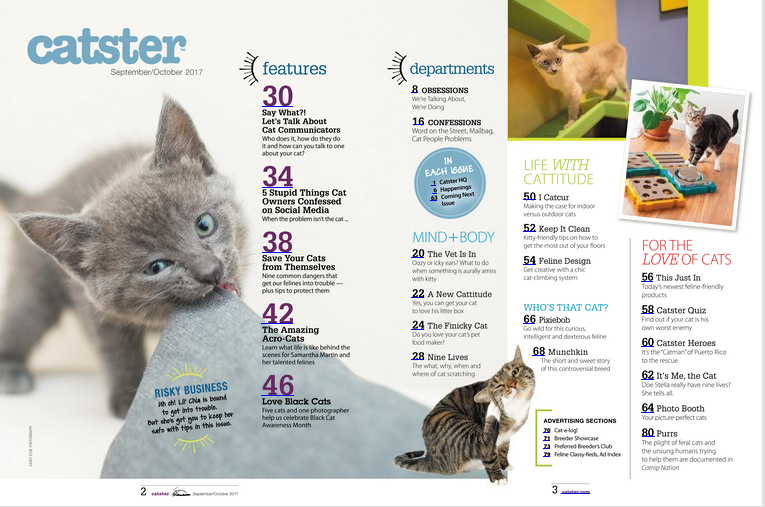Catser Table of Contents
Today, I will be doing something similar to the last post. However, instead of comparing the covers of three Caster magazines issues, I will be comparing the table of contents of three different issues. The purpose of the table of contents is to showcase what will be featured in the magazine. It is typically one of the first things that a person sees, as they would want to know what the magazine contains. Thus, it makes sense to want to create a certain style within your tables of content that would me memorable and enticing. By comparing the Catster magazines, I will make note of the efforts made to accomplish that, talking about them and taking from them for my own magazine's table of contents.
Each issue has 80 pages. This forms consistency; it makes it a memorable trait of Catster. Not only are there 80 pages, but each magazine divides those pages into the same sections, and some pages are kept with the same topics/features. For example, each issue has Obsessions and Confessions pages. These are usually on the same page number (like page 8 for Obsessions). On these, they talk about things like cat people problems, what people do for their cats, etc. Then there are the Mind+Body, Life with Cattitude, and For the Love of Cats sections. By having these occur in each table of contents, Catser creates a formula for their work. They know what they have to make because of what each section would hold, and readers know what they could expect to find in each issue. This could also form anticipation. I now know that there will be a section that will discuss lifestyles, but since the pages in those sections change, I do not know what to expect. I anticipate reading the next issue because I want to know what they will do next. Will they show off extraordinary felines? Will they display different cat cleaning products? Will they do something completely new? Since I enjoy consistency, I would adopt the page methods used by Catster, meaning I would have the same amount of pages shown, and I would use sections to divide all the topics I want to touch upon, similar to what we do in the school's yearbook.
Each table of contents is a spread, meaning two pages. On the left page, there is always a large photo of a cat. They have the cat reflect a theme within the issue. For example, the festive issue that came during winter has a cat with a Santa hat. Another has a cat being held by a tattooed arm, reflective of an included topic called Fine Art. I like this visual and text connection, it makes the magazine seem more uniform in a way, and holding your theme throughout your piece is always important. This is a technique I would use in my magazine for those reasons. Catser also places smaller, cropped and uncropped pictures around the text. The images are dependent of the text, so the page reading Cat Designs has a feline within a designed home. This helps further grasp the content that is written, so I would want to do this as well. It's simple, yet effective.
The text is either blue, green, or red depending on the section. I like this because it helps organize the magazine. We did something similar in yearbook. This allows the reader to know what section they are in; it makes it so that they do not have to quickly flip to the front of the section to see what they are reading, this makes it easier for them to understand. I like this and I have experience with color coating, so I will make use of this. The text is also in sans serif font, which is formal. It makes sense that you would want to be organized when trying to explain to people, you would want to be clear with what lies within the pages. This is an effective choice I would say.
With summarizing, Catster uses very small descriptions. For instance: "It's all about that butt!" These give off an idea of what is going to be shown without spoiling the details. This entices readers because we have this urge to find out. I would do this because by reading "It's all about that butt!", I want to find out more about the cat butts.




Comments
Post a Comment